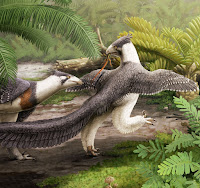 |
| Hesperornithoides miessleri
Hartman, Mortimer, Wahl, Lomax, Lippincott & Lovelace, 2019
DOI: 10.7717/peerj.7247
|
Abstract
The last two decades have seen a remarkable increase in the known diversity of basal avialans and their paravian relatives. The lack of resolution in the relationships of these groups combined with attributing the behavior of specialized taxa to the base of Paraves has clouded interpretations of the origin of avialan flight. Here, we describe Hesperornithoides miessleri gen. et sp. nov., a new paravian theropod from the Morrison Formation (Late Jurassic) of Wyoming, USA, represented by a single adult or subadult specimen comprising a partial, well-preserved skull and postcranial skeleton. Limb proportions firmly establish Hesperornithoides as occupying a terrestrial, non-volant lifestyle. Our phylogenetic analysis emphasizes extensive taxonomic sampling and robust character construction, recovering the new taxon most parsimoniously as a troodontid close to Daliansaurus, Xixiasaurus, and Sinusonasus. Multiple alternative paravian topologies have similar degrees of support, but proposals of basal paravian archaeopterygids, avialan microraptorians, and Rahonavis being closer to Pygostylia than archaeopterygids or unenlagiines are strongly rejected. All parsimonious results support the hypothesis that each early paravian clade was plesiomorphically flightless, raising the possibility that avian flight originated as late as the Late Jurassic or Early Cretaceous.
 |
| Figure 3: Reconstructed quarry map of WYDICE-DML-001. Association of skeletal elements assembled from 3D scans of specimen blocks prior to final mechanical preparation. Scale bar = 6 cm. |
 |
| Figure 4: Primary blocks of WYDICE-DML-001. “Left” (A) and “right” (B) sides of the blocks after final preparation (B). Scale bar = one cm. Images taken by Levi Shinkle |
Systematic Palaeontology
Theropoda Marsh, 1881
Maniraptora Gauthier, 1986
Paraves Sereno, 1997
Deinonychosauria Colbert & Russell, 1969
Troodontidae Gilmore, 1924
Hesperornithoides miessleri gen. et sp. nov.
Holotype: WYDICE-DML-001 (Wyoming Dinosaur Center, Thermopolis), a single, partially articulated skeleton consisting of most of an articulated skull and mandibles missing the anteriormost portions, hyoids, five cervical vertebrae, first dorsal vertebra, isolated anterior dorsal rib, portions of 12 caudal vertebrae, five chevrons, partial left scapula and coracoid, portions of the proximal left humerus and distal right humerus, left ulna and radius, radiale, semilunate carpal, left metacarpals I–III, manual phalanges III-2 and 3, manual unguals I, II, and III, ilial fragment, most of an incomplete femur, right and left tibiae and fibulae, left astragalus and calcaneum, portions of right and left metatarsal packets, left pedal phalanges III-1, III-2, III-3, IV-1, IV-2, IV-3, IV-4, and pedal unguals II and III and the proximal portion of IV.
Etymology: “Hesper,” (Greek) referring to the discovery in the American West, “ornis,” (Greek) for bird and “oeides,” (Greek) for similar, referring to the avian-like form of derived paravians. The trivial epithet honors the Miessler family, who have been avid supporters of the project.
Occurrence: Douglas, Converse County, Wyoming, USA; middle portion of Morrison Formation, which has been variously dated between Oxfordian and Tithonian in age (Trujillo, 2006; Trujillo et al., 2014), associated vertebrate fossils include the sauropod Supersaurus, a stegosaurid plate, and isolated large theropod teeth.
Diagnosis: A paravian with the following derived characters: pneumatic jugal (also in Zanabazar and some eudromaeosaurs among maniraptorans); short posterior lacrimal process (<15% of ventral process length, measured from internal corner; also present in Zanabazar, Archaeopteryx, and Epidexipteryx); quadrate forms part of lateral margin of paraquadrate foramen; small external mandibular fenestra (<12% of mandibular length; also in Zhenyuanlong and Dromaeosaurus among non-avian paravians); humeral entepicondyle >15% of distal humeral width (also in some avialans); manual ungual III subequal in size to ungual II (also in Daliansaurus, IGM 100/44 and Mahakala); mediodistal corner of tibia exposed anteriorly (also in Archaeopteryx and Jeholornis).
 |
| Figure 5: Rigorous skeletal reconstruction of WYDICE-DML-001. Scale bar = 25 cm. |
Conclusions:
We have described Hesperornithoides miessleri, a new paravian theropod from the Late Jurassic of North America. We ran a phylogenetic analysis based on previous TWiG datasets with expanded taxonomic sampling and recovered it as a troodontid, the oldest diagnostic specimen from North America known from more than teeth. Hesperornithoides was clearly a non-volant, terrestrial theropod that spent at least a portion of its life in a marginal lacustrine or wetland environment. The terrestrial and flightless lifestyle is consistent with the base of Paraves, and with the base of paravian subclades, suggesting that avian flight evolved within Avialae, most likely in the Late Jurassic or Early Cretaceous.
Scott Hartman, Mickey Mortimer, William R. Wahl, Dean R. Lomax, Jessica Lippincott and David M. Lovelace. 2019. A New Paravian Dinosaur from the Late Jurassic of North America supports A Late Acquisition of Avian Flight. PeerJ. 7:e7247. DOI: 10.7717/peerj.7247
Meet Lori, a tiny dinosaur that may help explain how birds evolved flight on.natgeo.com/2NHQ5RR @NatGeoScience








